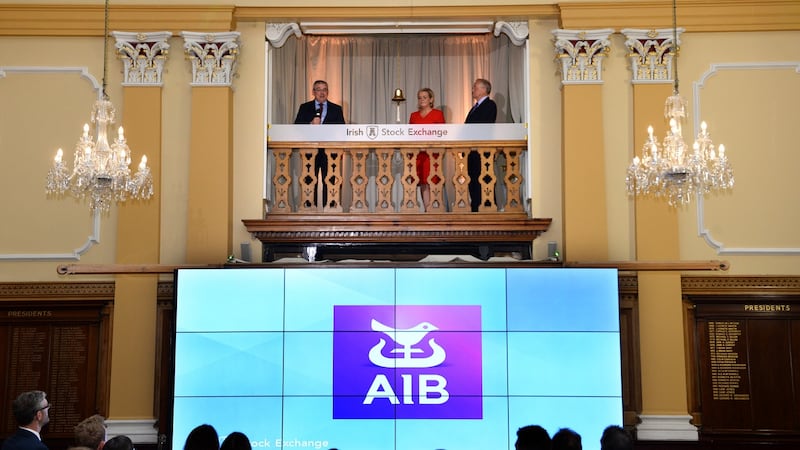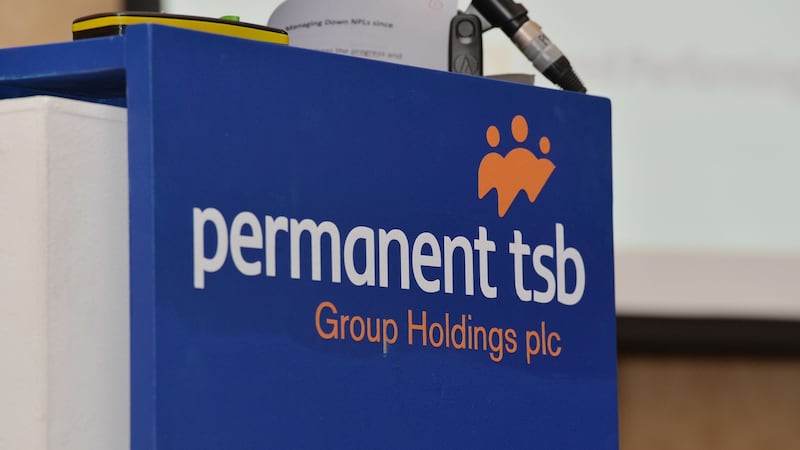AIB and Bank of Ireland have emerged from the wreckage of the Republic's financial system a decade ago with a near-dominant position in the market. Within the last week, both partially State-owned lenders published results for the first six months of this year showing healthy profits and a decreasing legacy of crisis-era bad debts.
On Monday, Bank of Ireland said it made an underlying profit of €500 million in the six months ended June 30th. It had cut bad debts to €5.9 billion, 7.5 per cent of the €77 billion it had lent out to its customers at the halfway point in the year.
Days earlier, AIB under chief executive Bernard Byrne said its surplus for the same six-month period reached €762 million, aided by the €140 million sale to US vulture fund Cerberus of loans that had fallen into arrears. That deal left the bank with €7.5 billion worth of legacy bad debts on its books, 12 per cent of the €61 billion total that its customers owed on June 30th.

Taken together, the lenders’ figures showed that they shared 60 per cent of the Republic’s mortgage market. On June 30th, homeowners’ liabilities to AIB totalled €33 billion, which it calculated was a 32 per cent slice of the cake. Bank of Ireland had loaned €23.7 billion against customers’ dwellings, which it said was 28 per cent.
Adding their figures together implies total mortgages in the Republic come to €94.7 billion, with their combined total just below 60 per cent of this. The remaining 40 per cent is split between Permanent TSB, which this week sold 10,700 home loans in deep arrears to US fund Lone Star for €1.3 billion, Ulster Bank and Belgian-owned KBC. On a tier below them are niche players such as Pepper and Dilosk.
Consumer activist David Hall, chief executive of the Irish Mortgage Holders' Association, argues that this dominant position allowed the two main banks to once again "generate massive profits" in the first half of the year. "We should be asking why other banks are not coming in," he says.
Less competition
Received wisdom has it that less competition means consumers here pay more to the banks than those in countries where larger numbers of financial institutions vie for their business. Official figures put the average interest rate charged for borrowing to buy a home in this country at 3.2 per cent, against 1.8 per cent across the euro zone and as little as 1 per cent in Scandinavian nations.
The evidence suggests the share of the big two is increasing. Bank of Ireland chief executive Francesca McDonagh said its mortgage business had grown by €1 billion or 30 per cent over the six months, while the overall market expanded by 22 per cent. She expected the lender’s decision to start selling homeloans through brokers from September to add yet more momentum. AIB, meanwhile, had recruited 36 per cent of all those in the Republic who bought their first home during the six-month period.
Observers say both banks have the muscle to maintain and grow their share against disparate rivals, some of whom are still wrestling with the worst effects of the crisis. There is nothing new in this, according to broker Michael Dowling of Dowling Financial, who estimates that the two also have 75 per cent of the Republic's current accounts.
Dowling refers to AIB and Bank of Ireland as the “big beasts” and points out that they have the networks, marketing budgets and cash to see off any competitors who stray into their territory. “I don’t see any other players wanting to come into the Irish market,” he says. “The difficulty with two such dominant players is you are only fighting for scraps.”
He acknowledges that rivals such as Permanent TSB have possibly chipped away at the big beasts' share, mostly by aping the cash-back offers that they use to lure customers to the fixed-rate mortgages they are selling. However, Dowling says that the reality is that there are few who are really going to take on the pair. Before the crisis, Bank of Scotland, Danske and a few more tried, but they retreated licking their wounds.

Dowling wishes he had a euro for every person he has met from a European or British bank that has run the rule over the Republic’s market only to walk away. Not only do potential entrants have to deal with a near-duopoly, they have to do it in a market of less than 4.5 million people, about the size of greater Manchester. “Why would you commit to an economy that is no bigger than the third-biggest city in your own jurisdiction?” he asks.
Size matters
So size matters, at least to bankers. But perhaps it should not. Just up the road in the North, a market around one quarter the size of the Republic's, you will find AIB, Bank of Ireland, Ulster, Barclays, Danske and HSBC among a total of 14 or 15 players.
Billy Kane, now of Finance Ireland, formerly chief executive of Irish Life and Permanent – once the owner of Permanent TSB – says that is simply because the North is part of the UK, so those banks regard it as part of a market of 60 million people rather than a self-contained one of less than 1.5 million.
He thinks there is little chance that any of the UK banks will venture across the Border, particularly with Brexit looming next March. Along with those considerations, Kane thinks this State has set the regulatory bar very high, although he can see the logic for this.
“We have come through a very difficult time in this country and a lot of people got themselves into financial difficulty and had to be protected, and that is fair enough,” he argues. The result, he maintains, is that the consumer protection regime here is amongst the strongest in the world.
This is less of a problem if you are already here, but from the perspective of banks looking in from the outside, Kane points out that they have to look at what implications this has for them and the security they get over their loans. He is not suggesting a retreat to the “light” – effectively non-existent – regulation that was a key cause of the crisis. Nor is he advocating that banks should simply be allowed to walk off with family homes in cases of default. “Consumers have to be protected,” he says, “it’s about balanced regulation.”
Eamonn Hughes, a banking analyst with Goodbody Stockbrokers, agrees that lenders will take into account the fact that it takes a long time in this jurisdiction for them to get hold of the actual property if someone does not pay back their mortgage. However, he questions whether this heavily influences potential entrants' thinking. "I would think the same thing applies if you are already here," he observes.
The actual regulator – the Central Bank of Ireland – would argue that the rules here are the same as for banks across the EU, as they are all subject to the single supervisory mechanism. That institution's primary role is to act as a watchdog, but it acknowledges that competition can be good for consumers. Its deputy governor, Ed Sibley, recently agreed that the number of players here was small and that home lending was concentrated in relatively few hands.
Hangover
Like everyone else, he suggested that the market’s size was to blame, along with the high level of bad debt that remains as a hangover from the crisis. Although it was 10 years ago, the financial collapse still looms large in Irish banking. The State had to pay billions to bail out the banks and to this day it retains 71 per cent of AIB, 14 per cent of Bank of Ireland and 75 per cent of Permanent TSB.

This raises the question of whether or not the Government – and specifically the Minister of Finance, Paschal Donohoe, who holds the shares on our behalf – believes that more competition in banking is a good thing. He has repeatedly said that the Government is indeed committed to boosting competition in the sector. Not only that, he has invited potential new entrants to contact the Central Bank and his department.
Donohoe made his most recent statement on the issue when the Government published a report on one option it explored in depth: local public banking. This is based on a system used in Germany where the State finances lenders that are charged with serving consumers and small business in specific geographic areas. They are "not-for-profit" which does not mean they should not aim to generate a surplus, but simply that they must re-invest it in the regions where they operate.
Dermot Ryan, general secretary of the Financial Services Union, the industry's biggest labour organisation, supports the idea. "It would cost about €170 million," he says. "The State was willing to support the Rugby World Cup, which would have cost twice that."
In his view, the advantages are clear in that such banks provide consumers – including home buyers – and small business with cheap finance. His logic is that if the public banks cut their rates, it will force the private sector players to follow. Donohoe was not so sure. He said that the Government had decided not to pursue this, but he pledged to commission a further review looking at how the concept could be promoted in the Republic.
Ryan believes this is symptomatic of a “lack of vision” when it comes to domestic banking. “The Government has a very clear strategy for international financial services, but none for the Irish banks,” he argues.
Another, more conventional, option that Donohoe and his colleagues have reportedly explored is merging Permanent TSB and Ulster, a move that would cut the actual number of market players but create one larger business potentially capable of matching the big two. Danièle Nouy, chairwoman of the European Central Bank's supervisory board, recently raised this with the Department of Finance at a series of meetings where she was critical of the Republic's banking system.
Marriage of convenience
Both Dowling and Kane acknowledge that this may be one way forward, but are dubious if it would work, as it involves a marriage of convenience between two partners with their own internal difficulties and different cultures. Part of Nouy’s reasoning was the high level of bad debts on Permanent TSB’s books, which was 25 per cent at the time she raised the issue. This week’s sale to Lone Star has cut that to 16 per cent.
Not everyone buys wholly into the idea that competition is poor and only new entrants can rectify this. Hughes points to evidence that normal commercial rivalry is growing. For instance, he notes that Permanent TSB’s share of mortgages has grown in recent years from 9 per cent to 14.6 per cent, AIB’s is down from the high 30s while Bank of Ireland’s has increased.
He singles out remortgaging, where people move their home loans from one bank to another, as a good measure of competition. This has been growing. “It’s gone from around 4 per cent of flows to 11 per cent,” Hughes says. He also explains that high interest rates result from many factors, including the risks the banks are taking and the steps they must take against those hazards. New entrants would be just as subject to those as established players.
One obvious risk is that the borrower will not repay the bank. Lenders assess this against recent history. “The experience here over the last 20 years has been poor,” Hughes points out. Similarly, the Central Bank recently imposed extra safeguards against insolvency. Bank of Ireland confirmed on Monday that these would cost it an extra €650 million a year.
Hughes says financial institutions pass those costs on to customers. He also argues that they partly explain the higher rates that borrowers here pay, as the risks are lower in jurisdictions such as Scandinavia, where charges are around one third of what they are here.
Ultimately, we may have to settle for the status quo. If that is the case, then David Hall argues that it will be up to the State to ensure that consumers are not “gouged with charges or gouged with bad behaviour”. Regulators will have to get tough, he says. “They have got to take control, put manners on the banks and have less happy-clappy cultural reports.”






















